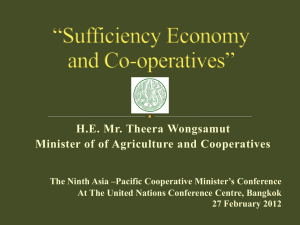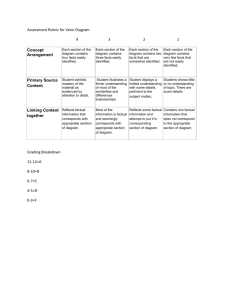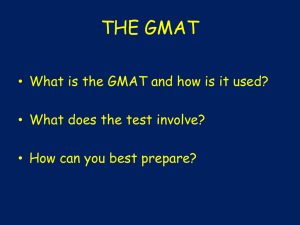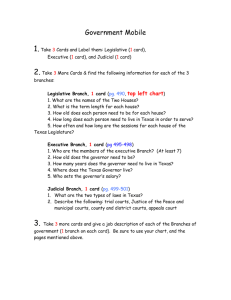FACTUAL AND LEGAL SUFFICIENCY OF THE
advertisement
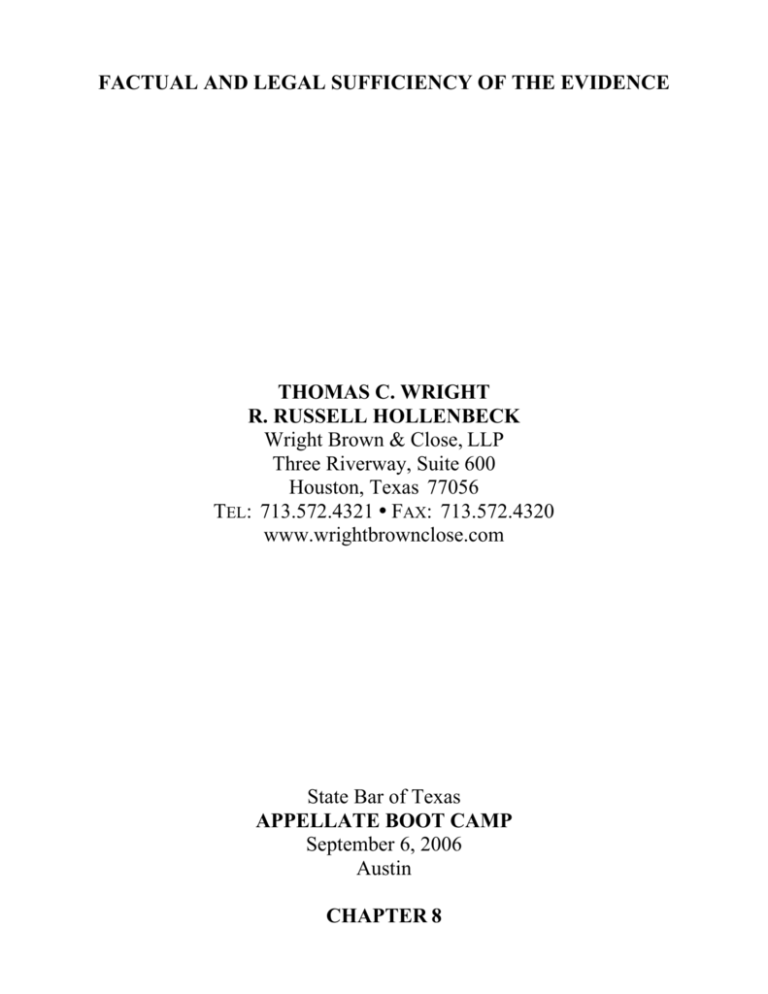
FACTUAL AND LEGAL SUFFICIENCY OF THE EVIDENCE THOMAS C. WRIGHT R. RUSSELL HOLLENBECK Wright Brown & Close, LLP Three Riverway, Suite 600 Houston, Texas 77056 TEL: 713.572.4321 y FAX: 713.572.4320 www.wrightbrownclose.com State Bar of Texas APPELLATE BOOT CAMP September 6, 2006 Austin CHAPTER 8 WRIGHT BROWN & CLOSE, LLP THREE RIVERWAY, SUITE 600 HOUSTON, TEXAS 77056 TEL: 713-572-4321 ♦ FAX: 713-572-4320 www.wrightbrownclose.com THOMAS C. WRIGHT — B.A. Wheaton College, 1977, with honors. J.D. University of Texas, 1980, with high honors. Order of the Coif, Grand Chancellor. Law Clerk for Hon. Charles Clark, Chief Judge, U.S. Court of Appeals for the Fifth Circuit, 1980-1981. Assistant to the General Counsel, Dept. of the Army, 19811985. Associate and Partner, Miller Bristow & Brown, 1985-1991. Founding Partner, Brown Campbell Harrison & Wright, 1991-1995; Campbell Harrison & Wright 1995-2001. Managing Partner, Wright, Brown & Close, LLP. Mr. Wright has extensive trial and appellate experience in business cases, including oil and gas, breach of contract, and fiduciary litigation for plaintiffs and defendants. Mr. Wright has argued cases in the Texas Supreme Court, the United States Courts of Appeals for the Fifth and Ninth Circuits, and most of the fourteen intermediate appellate courts in Texas. He also has expertise in preservation of error, the court's charge, and post-trial motion practice, and has spoken on those subjects at numerous continuing legal education seminars. He is a contributing author to the chapters on Discovery and Liability Insurance in Professor William Dorsaneo’s TEXAS LITIGATION GUIDE. In 2003 and 2004, Mr. Wright was designated a “Super Lawyer” by Texas Monthly magazine. Mr. Wright is board certified both in Civil Trial Law and in Civil Appellate Law by the Texas Board of Legal Specialization. WRIGHT BROWN & CLOSE, LLP THREE RIVERWAY, SUITE 600 HOUSTON, TEXAS 77056 TEL: 713-572-4321 ♦ FAX: 713-572-4320 www.wrightbrownclose.com R. RUSSELL HOLLENBECK — B.A. Political Science, Williams College, 1990, cum laude. J.D. University of Texas School of Law, 1994. Briefing Attorney, First Court of Appeals, 1994-1996. Associate, Ramsey & Murray, PC, 1996-2001. Staff Attorney, First Court of Appeals, 2001-2004. Senior Associate, Wright, Brown & Close, LLP, 2005 to present. Member: State Bar of Texas Appellate Section, Houston Bar Association Appellate Section. Mr. Hollenbeck has experience in both trial and appellate matters. In private practice, he assisted in or handled all phases of litigation for a wide variety of clients involved in products liability, premises liability, personal injury, and commercial lawsuits in state and federal court. At the court of appeals, he researched legal and factual issues, made recommendations to the judges, and assisted the judges in drafting and editing opinions on a wide variety of complex civil appeals and original proceedings. In 2005, Mr. Hollenbeck was named a “Rising Star” by Texas Monthly magazine. Factual and Legal Sufficiency of the Evidence Chapter 8 TABLE OF CONTENTS I. INTRODUCTION................................................................................................................................................... 1 II. WHAT ARE THE ORIGINS OF LEGAL AND FACTUAL SUFFICIENCY REVIEW?.................................... 1 III. WHAT DOES A SUFFICIENCY CHALLENGE MEASURE? ............................................................................ 1 IV. WHAT ARE THE EVIDENTIARY STANDARDS OF REVIEW?...................................................................... 2 A. Legal Sufficiency Challenges.......................................................................................................................... 2 1. “There is no evidence to support the finding” ......................................................................................... 2 2. “The evidence conclusively establishes the opposite of the finding”...................................................... 3 B. Factual Sufficiency Challenges ....................................................................................................................... 3 1. “The evidence is too weak to support the finding”.................................................................................. 4 2. “The great weight and preponderance of the evidence is contrary to the finding”.................................. 4 V. HOW ARE SUFFICIENCY CHALLENGES AFFECTED BY ELEVATED BURDENS OF PROOF?.............. 5 VI. HOW MAY A SUFFICIENCY CHALLENGE BE PRESERVED FOR APPEAL? ............................................. 6 VII. HOW MUCH DETAIL MUST APPELLATE COURTS GIVE IN SETTING OUT THEIR ANALYSIS OF A SUFFICIENCY CHALLENGE? ............................................................................................................................ 6 VIII. CONCLUSION ..................................................................................................................................................... 7 i Factual and Legal Sufficiency of the Evidence Chapter 8 that “the decision of [the courts of appeals] shall be conclusive on all questions of fact brought before them on appeal or error.” TEX. CONST. art. V, § 6. Accordingly, the fourteen intermediate courts of appeals have final authority over questions of fact (i.e., the factual sufficiency of the evidence), such as whether the evidence supporting a finding is so weak that the finding is clearly wrong or whether the great weight and preponderance of the evidence is so contrary to the finding that it is manifestly unjust. Thus, as a result of what has been described as Article V’s “factual conclusivity” clause, only the intermediate courts of appeals may pass upon challenges to the factual sufficiency of the evidence. See Garza, 164 S.W.3d at 620-21. Although the Texas Supreme Court may not consider the merits of a factual sufficiency challenge, it may consider whether a court of appeals has correctly applied the proper factual sufficiency standard of review. See Pool v. Ford Motor Co., 715 S.W.2d 629, 632 (Tex. 1986) (“Thus, we remand to the court of appeals for it to determine, pursuant to the correct standard, [the factual sufficiency of the evidence to support the jury’s findings].”). Perhaps the most famous (and most frequently quoted) law review article in Texas was authored by former Chief Justice Robert W. Calvert and addresses the standards for reviewing both legal and factual sufficiency. Robert W. Calvert, “No Evidence” & “Insufficient Evidence” Points of Error, 38 TEX. L. REV. 361, 362-64 (1960) (hereinafter “Calvert”). The Texas Supreme Court and other courts of appeals have cited to this article frequently, and it should be considered “required reading” for appellate advocates. See City of Keller v. Wilson, 168 S.W.3d 802, 810 (Tex. 2005) (noting Calvert’s article had been cited by Texas courts “more than 100 times” in the preceding five years). Another excellent and comprehensive source for analyses of all standards of review is a law review article authored by Wendall Hall and updated periodically. See, e.g., W. Wendell Hall, Standards of Review in Texas, 34 St. Mary’s L. J. 1 (2002) (hereinafter “Hall”).1 FACTUAL AND LEGAL SUFFICIENCY OF THE EVIDENCE I. INTRODUCTION A challenge to the sufficiency of the evidence supporting a fact finding – whether in a jury’s answer to a question in the court’s charge or in a fact finding made by a trial court – is one of the most commonly used appellate attacks on an adverse judgment. Such a challenge may, in separately briefed issues, question both the legal and factual sufficiency of the evidence. In deciding whether to present a challenge to the sufficiency of the evidence and how to frame such a challenge, an appellate advocate must first consider the standard of review that is to be applied by the court of appeals. Correctly identifying the proper standard of review is crucial – courts of appeals generally do not look kindly on the arguments of advocates who misstate the standard of review. Understanding the standard of review, and how your issue fits within that standard, is also critical to success. Comprehending the scope and nuances of the applicable standard of review will enable you to frame an issue so as to play to the strengths of your argument, and will greatly increase your chances of success on appeal. In order to assist new civil appellate practitioners, this paper is intended to present a brief review of the basics concerning challenges to the legal and factual sufficiency of the evidence in a civil case, in light of recent opinions from the Texas Supreme Court. II. WHAT ARE THE ORIGINS OF LEGAL AND FACTUAL SUFFICIENCY REVIEW? The Texas Constitution sets the limits on the types of evidentiary review that can be performed by the Texas Supreme Court, the Court of Criminal Appeals, and the fourteen intermediate courts of appeals. Article V, section 3 of the Constitution provides that the appellate jurisdiction of the Texas Supreme Court “shall be final and shall extend to all cases except in criminal law matters and as otherwise provided in this Constitution or by law.” TEX. CONST. art. V, § 3. Thus, with regard to issues of evidentiary review, the Texas Supreme Court has final authority over questions of law (i.e., the legal sufficiency of the evidence), such as whether there is a complete absence of evidence to support a particular finding or whether the evidence conclusively establishes the opposite of the finding. See, e.g., Southwestern Bell Telephone Co. v. Garza, 164 S.W.3d 607, 620 (Tex. 2004) (citing Missouri Pac. Ry. v. Somers, 14 S.W. 779, 779 (Tex. 1890) (“[I]t is elementary that whether there be any evidence or not to support an issue is a question of law . . . .”)). The finality of the Court’s appellate authority is tempered by section 6 of Article V, which provides III. WHAT DOES A SUFFICIENCY CHALLENGE MEASURE? In most cases, a legal or factual sufficiency point is used to challenge the sufficiency of the evidence supporting a jury finding, or the failure of the jury to make a finding, in its answers to the court’s charge. See, e.g., Garza, 164 S.W.3d at 618. However, legal and factual sufficiency challenges also may be raised against findings of fact made by a judge following a 1 1 The authors acknowledge their reliance on both Calvert’s and Hall’s articles in the preparation of this paper. Factual and Legal Sufficiency of the Evidence Chapter 8 sufficiency of the evidence to support a finding, Justice Calvert wrote: bench trial. See Catalina v. Blasdel, 881 S.W.2d 295, 297 (Tex. 1994). In such cases, the reviewing appellate court will consider the trial court’s findings of fact by applying the same standards of review applied to jury findings. Id. Keep in mind that, in the absence of an objection to the language submitted to the jury in the court’s charge, the sufficiency of the evidence will be measured against whatever language was considered by the jurors, not against an abstract (or even more correct) statement of the law. Garza, 164 S.W.3d at 619-20 (assuming charge language given without objection correctly stated the law); Wal-Mart Stores, Inc. v. Sturges, 52 S.W.3d 711, 715 (Tex. 2001) (holding sufficiency of evidence must be assessed “in light of the jury charge the district court gave without objection”); Bradford v. Vento, 48 S.W.3d 749, 754 (Tex. 2001) (same); Osterberg v. Peca, 12 S.W.3d 31, 55 (Tex. 2000) (“It is the court’s charge, not some other unidentified law, that measures the sufficiency of the evidence when the opposing party fails to object to the charge”). The proper methods for making objections to the court’s charge and for preserving appellate challenges to errors in the charge are subjects for another paper. “No evidence” points must, and may only, be sustained when the record discloses one of the following situations: (a) a complete absence of evidence of a vital fact; (b) the court is barred by rules of law or of evidence from giving weight to the only evidence offered to prove a vital fact; (c) the evidence offered to prove a vital fact is no more than a scintilla; (d) the evidence establishes conclusively the opposite of the vital fact. .... [T]he courts follow the further rule of viewing the evidence in its most favorable light in support of the finding of the vital fact, considering only the evidence and the inferences which support the finding and rejecting the evidence and the inferences which are contrary to the finding. See Calvert at 362-64 (quoted by City of Keller, 168 S.W.3d at 810). IV. WHAT ARE THE EVIDENTIARY STANDARDS OF REVIEW? There are essentially two standards of review for either a legal or a factual sufficiency challenge: (a) the standard applied to review a challenge to a finding on which the challenging party did not bear the burden of proof, and (b) the standard applied to review a challenge to an adverse finding on which the challenging party bore the burden of proof. The former challenges the fact finder’s determination that the opposing party carried its burden of proof on an issue, while the latter attacks the fact finder’s determination that the challenging party failed to meet its evidentiary burden. As further noted by Justice Calvert, “[t]he rule as generally stated is that if reasonable minds cannot differ from the conclusion that the evidence lacks probative force it will be held to be the legal equivalent of no evidence.” Id. at 364. The standard of review for a no evidence point, as stated by Justice Calvert and as recently restated by the Texas Supreme Court, has been presented generally as an “exclusive” standard; that is, a reviewing court must consider only the evidence supporting the finding and must reject evidence contrary to the finding. See, e.g., Lenz v. Lenz, 79 S.W.3d 10, 19 (Tex. 2002) (holding that, under legal sufficiency review, appellate courts “must disregard all evidence and inferences contrary to the jury’s finding”). However, in the most recent case from the Texas Supreme Court to thoroughly discuss the legal sufficiency standard of review, this standard has been clarified (or modified, according to some commentators). In City of Keller, the Court held that some cases constituted exceptions to the traditional, “exclusive” legal sufficiency standard of review and would require an appellate court to consider all the evidence in the record to make a proper sufficiency review. However, the Court noted that because the differences between an exclusive review and an inclusive review “are more semantic than real,” there was no compelling reason to choose among them. Id. at 827. The Court explained that “the traditional rule in Texas has never been that appellate courts must reject A. Legal Sufficiency Challenges A challenge to the legal sufficiency of the evidence is an assertion by the losing party that result at trial was incorrect and that it should have prevailed at trial as a matter of law. This is because the remedy for a successful legal sufficiency point is generally a rendition of judgment in favor of the party making the challenge. See Holt Atherton Indus. v. Heine, 835 S.W.2d 80, 86 (Tex. 1992). 1. “There is no evidence to support the finding” When a party challenges the legal sufficiency of the evidence to support a finding on which its opponent bore the burden of proof, the issue is considered a “no evidence” point. With regard to challenges to the legal 2 Factual and Legal Sufficiency of the Evidence Chapter 8 Sterner v. Marathon Oil Co., 767 S.W.2d 686, 690 (Tex. 1989). If there is no evidence that supports the finding, the appellate court must then consider the entire record to determine whether the contrary proposition was established as a matter of law. Dow Chem. Co., 46 S.W.3d at 241. The legal sufficiency challenge will be sustained only if the contrary proposition was conclusively established by the evidence. Id. In essence, a “matter of law” legal sufficiency challenge (raised by a party claiming to have conclusively established the opposite of a fact finding) is the opposite of a “no evidence” legal sufficiency challenge (raised by a party claiming that no evidence supports the fact finding). contrary evidence in every no-evidence review.” Id. at 810. Rather, there are cases in which a review of all the evidence presented will be necessary to a determination of whether the evidence was legally sufficient. Id. at 811 (“[I]n a number of cases, the lack of supporting evidence may not appear until all the evidence is reviewed in context.”). Such cases include defamation claims and contractual claims, where appellate courts must give consideration to the entire contents of either the publication or the parties’ contract. Id. at 811-12. In addition, appellate courts may be required to review the entire record to determine whether evidence that, taken alone, might constitute “more than a scintilla” is in fact, incompetent to support the verdict. As noted above, the evidence will not exceed the “more than a scintilla” standard if it is so weak as to do no more than create a mere surmise or suspicion that the fact exists. Kroger Tex. Ltd. P’ship v. Suberu, 49 Tex. Sup. Ct. J. 592, 2006 Tex. LEXIS 441 (Tex. May 6, 2006). This situation most often arises in circumstantial evidence cases, where competing inferences may be drawn from the evidence. Where claims (or affirmative defenses) are supported only by meager circumstantial evidence, the evidence will not rise above the scintilla standard (and will be legally insufficient) “if jurors would have to guess whether a vital fact exists.” City of Keller, 168 S.W.3d at 813. The Texas Supreme Court has explained that “[w]hen the circumstances are equally consistent with either of two facts, neither fact may be inferred.” Id. (citing Tubelite v. Risica & Sons, Inc., 819 S.W.2d 801, 805 (Tex. 1991)). In Keller, the Court also reaffirmed that the final test for legal sufficiency “must always be whether the evidence at trial would enable reasonable and fairminded people to reach the verdict under review.” Id. at 827. Put simply, in reviewing a verdict for legal sufficiency, courts of appeals should give credit to evidence that supports the verdict if reasonable jurors could have done so, and should disregard contrary evidence, unless reasonable jurors could not have done so. Id. B. Factual Sufficiency Challenges A factual sufficiency challenge is an assertion by the losing party that the result at trial was flawed because the evidence, although legally sufficient to support the trier of fact’s findings, was so lacking as to make the result fundamentally unfair or manifestly unjust. Pool v. Ford Motor Co., 715 S.W.2d 629, 632 (Tex. 1986). It is a challenge to the degree of the evidence supporting the trial result, not the existence of any evidence in support of the verdict. The remedy for a party who successfully prevails on a factual sufficiency challenge is a remand for a new trial. Id. In the context of a factual sufficiency challenge, Pool is one of the most frequently cited cases setting out the standards of review. As noted above, the Texas Supreme Court may not conduct its own factual sufficiency review, but it will often direct the intermediate courts of appeals to consider Pool when doing so. See, e.g., In re Smith, 49 Tex. Sup. Ct. J. 609, 2006 Tex. LEXIS 437 (Tex. May 5, 2006) (directing court of appeals to consider Pool in evaluating factual sufficiency of trial court’s findings). Advocates should bear in mind the scope of appellate factual sufficiency review and its limits. Because of the deference courts must give to the jurors’ authority to judge the credibility of the witnesses and weight of the testimony, the boundaries on the determinations courts of appeals can make in conducting a factual sufficiency review are sometimes difficult to perceive. Although the intermediate courts of appeals are permitted to conduct a review of the factual sufficiency of the evidence to support a finding, in doing so, they may not substitute their own judgment for that of the jury. Golden Eagle Archery, Inc. v. Jackson, 116 S.W.3d 757, 761 (Tex. 2003). Thus, it remains the sole province of the jury to judge the credibility of the witnesses and the weight to be given their testimony. Id.; see also Garza, 164 S.W.3d at 625 (“Issues of credibility that depend on appearance and demeanor cannot be weighed by the appellate court; the witnesses are not present. And 2. “The evidence conclusively establishes the opposite of the finding” When a party challenges the legal sufficiency of the evidence to support an adverse finding on an issue on which it bore the burden of proof, it is essentially arguing (and must show on appeal) that the evidence conclusively established the opposite of the finding as a matter of law. In considering a party’s “matter of law” challenge, a reviewing appellate court must conduct a two-prong analysis. It must first examine the record for evidence that supports the finding and ignore all evidence to the contrary. See Dow Chem. Co. v. Francis, 46 S.W.3d 237, 241-42 (Tex. 2001); 3 Factual and Legal Sufficiency of the Evidence Chapter 8 appeals to review for factual insufficiency must continue undisturbed.” Id. even when credibility issues are reflected in the written transcript, the appellate court must defer to the jury’s determinations, at least so long as those determinations are not themselves unreasonable.”). This is not a new principle. More than 100 years ago, the Texas Supreme Court similarly described the limits of the power of the intermediate courts of appeals in conducting a factual sufficiency review: 1. “The evidence is too weak to support the finding” A party attacking the factual sufficiency of the evidence supporting a finding on an issue for which the opposing party bore the burden of proof must demonstrate to the court of appeals the there was insufficient evidence to support the finding. See In re C.H., 89 S.W.3d 17, 19 (Tex. 2002). A reviewing court of appeals must consider all of the evidence in the record and determine whether the trier of fact could have reasonably concluded that the existence of the fact was more probable than not. Id. A factual sufficiency challenge will be sustained, and the finding set aside, only where the evidence supporting the finding is so weak as to be clearly wrong and manifestly unjust. Id. at 25. In Clewis v. State, 922 S.W.2d 126 (Tex. Crim. App. 1996), the Court of Criminal Appeals provided a colorful illustration of the difference between legal and factual sufficiency review in criminal cases that provides some helpful insight for understanding these two standards: It is contrary to the genius of our institutions, as well as to the letter and spirit of every constitution ever adopted in this State, to suppose that it was ever intended to substitute the judgment of the appellate courts upon the facts of a case in place of that of the jury, and to make the determination of these courts final. Choate v. San Antonio & A.P. Ry. Co., 44 S.W. 69, 70 (Tex. 1898). The Choate court explained that, although appellate courts could not find facts, if a jury finding was so against the great weight and preponderance of the evidence as to be manifestly incorrect, the courts of appeals could exercise their factual sufficiency review authority to unfind facts, reverse the judgment, and remand the cause for a new trial. Id.; see Pool, 715 S.W.2d at 634. This concept is somewhat easy to grasp when applied to the factual sufficiency review of affirmative jury findings. However, the same standard of review is to be applied when a jury makes a negative finding, creating at least the appearance of a court of appeals “stepping into the shoes” of the jury. As noted by the Texas Supreme Court in Pool, The prosecution’s sole witness, a paid informant, testifies that he saw the defendant commit a crime. Twenty nuns testify that the defendant was with them at the time, far from the scene of the crime. Twenty more nuns testify that they saw the informant [and not the defendant] commit the crime. Id. at 133 n.12. Although the prosecution may have provided legally sufficient evidence – through the informant’s incredible testimony – to support a finding of guilt, such evidence will likely not be considered factually sufficient to support such a finding (or even a civil finding of liability). The testimony of the forty nuns will likely make that of the paid informant so weak that a court of appeals reviewing a jury finding of guilt based on the informant’s testimony will conclude that it was clearly wrong and manifestly unjust. While a cogent argument may be made in support of the right to hold that insufficient evidence exists to uphold a jury’s affirmative finding, it becomes more difficult to rationalize why, when a jury fails to find a fact from a preponderance of the evidence, that non-finding should be set aside on a great weight and preponderance standard. That does appear to be allowing a substitution of thought processes. 2. “The great weight and preponderance of the evidence is contrary to the finding” When a party attacks the factual sufficiency of the evidence supporting an adverse finding on which it bore the burden of proof, it must demonstrate on appeal that the finding was against the great weight and preponderance of the evidence. See Dow Chem. Co. v. Francis, 46 S.W.3d 237, 241 (Tex. 2001). As with any factual sufficiency challenge, a court of appeals will review all the evidence to determine if the finding 715 S.W.2d at 634. Nevertheless, the intermediate courts of appeals are empowered to conduct factual sufficiency review of both affirmative and negative findings by the trier of fact. As the Court observed, “[i]f a constitutional conflict exists, it remains to the electorate of this state to eliminate the conflict. . . . The rights of courts of 4 Factual and Legal Sufficiency of the Evidence Chapter 8 The question is whether an elevated standard of proof at trial – here, clear and convincing evidence – requires a correspondingly elevated standard of evidentiary review on appeal. More specifically: will anything more than a scintilla of probative evidence – evidence “that would enable reasonable and fair-minded people to differ in their conclusions” – support a verdict of actual malice, as it would if proof at trial were by a preponderance of the evidence, or must there be more – must there be some evidence that produces a firm belief or conviction of the truth of the allegation, since that was the “clear and convincing” standard of proof the jury was required to apply? is so against the great weight and preponderance of the evidence that it is manifestly unjust, shocks the conscience, or clearly demonstrates bias. See In re C.H., 89 S.W.3d 17, 25 (Tex. 2002). The Pool case provides an example of a typical “great weight and preponderance” challenge. In that case, Ford Motor Company carried the burden of proving that the plaintiff’s own negligence was a proximate cause of the accident that injured him. However, the jury assigned no negligence to the plaintiff, despite evidence that he was intoxicated, drove his pickup truck at an excessive speed, permitted his truck to veer off the road, and failed to wear his seatbelt. Pool, 715 S.W.2d at 630. On appeal, Ford raised a factual sufficiency challenge to the jury’s failure to find the plaintiff negligent for the accident, contending that such finding was “so against the great weight and preponderance of the evidence as to be manifestly unjust.” Id. at 632. The court of appeals held that there was factually insufficient evidence to support the jury’s negative answer to the question of the plaintiff’s negligence, but was reversed on this particular issue by the Texas Supreme Court for applying an incorrect standard of review. Id. at 633. Id. at 620. In answering its own question, the Court held that, “as a matter of logic, a finding that must meet an elevated standard of proof must also meet an elevated standard of review.” Garza, 164 S.W.3d at 621-22. The Court explained its logic by comparing a finding based on clear and convincing evidence against a traditional legal sufficiency review requiring a party to show ‘more than a scintilla’ of evidence supported a fact finding. As noted above, evidence which does no more than create a mere surmise or suspicion cannot prove the truth of an allegation, is no more than a scintilla, and is not legally sufficient evidence. Id. at 621 (citing Calvert at 363). The difficulty of applying this standard to claims requiring an elevated standard of proof is that such claims, by their nature, require parties to present much more evidence to satisfy their burden. V. HOW ARE SUFFICIENCY CHALLENGES AFFECTED BY ELEVATED BURDENS OF PROOF? To prevail on certain claims, a party must establish proof beyond a mere preponderance of the evidence. In some circumstances, a party must establish the elements of its claim by clear and convincing evidence; that is, evidence sufficient to form a firm belief or conviction in the mind of the trier of fact concerning the truth of the allegation sought to be established. See In re J.F.C., 96 S.W.3d 256, 264 (Tex. 2002); In re C.H., 89 S.W.3d 17, 19 (Tex. 2002). Such cases include parental termination and involuntary commitment suits, as well as claims of gross negligence or malice. See Garza, 164 S.W.3d at 624-25, n.50, n.51, n.52 (setting out numerous constitutional, statutory, and common law sources of right to elevated standard of proof). In presenting a challenge to the legal and factual sufficiency of the evidence, an appellate advocate must take into account this elevated burden of proof and how it will affect the standard of review applied by the courts of appeals. In two recent parental termination proceedings, the Texas Supreme Court considered how the elevated “clear and convincing” burden of proof would affect an appellate court’s review of the evidence in response to legal and factual sufficiency challenges. In re J.F.C., 96 S.W.3d at 264; In re C.H., 89 S.W.3d at 19. The Court framed the issue as a question: [W]hen proof of an allegation must be clear and convincing, even evidence that does more than raise surmise and suspicion will not suffice unless it is capable of producing a firm belief or conviction that the allegation is true. Evidence of lesser quality is, in legal effect, no evidence. . . . In reviewing a finding that must be proved by clear and convincing evidence, it makes no sense for an appellate court to determine whether the supporting evidence amounts to more than a scintilla. Even if it does, the finding is invalid unless the evidence is also clear and convincing. Id. at 621. In answering this problem, the Texas Supreme Court proposed a procedure for appellate courts to use when conducting a legal sufficiency review of the 5 Factual and Legal Sufficiency of the Evidence Chapter 8 sufficiency challenge to such a finding will be sustained only if the trier of fact could not have reasonably found the facts to be established by clear and convincing evidence. evidence supporting a finding based on clear and convincing evidence. In a legal sufficiency review, a court should look at all the evidence in the light most favorable to the finding to determine whether a reasonable trier of fact could have formed a firm belief or conviction that its finding was true. To give appropriate deference to the factfinder’s conclusions and the role of a court conducting a legal sufficiency review, looking at the evidence in the light most favorable to the judgment means that a reviewing court must assume that the factfinder resolved disputed facts in favor of its finding if a reasonable factfinder could do so. A corollary to this requirement is that a court should disregard all evidence that a reasonable factfinder could have disbelieved or found to have been incredible. This does not mean that a court must disregard all evidence that does not support the finding. Disregarding undisputed facts that do not support the finding could skew the analysis of whether there is clear and convincing evidence. Id. VI. HOW MAY A SUFFICIENCY CHALLENGE BE PRESERVED FOR APPEAL? A challenge to the legal sufficiency of the evidence to support a jury’s fact finding can be preserved for appeal in a number of ways: (1) a motion for instructed verdict; (2) an objection to the submission of the issue to the jury; (3) a motion to disregard the jury’s answer to a vital fact issue; (4) a motion for judgment notwithstanding the verdict (JNOV); and (5) a motion for new trial. Cecil v. Smith, 804 S.W.2d 509, 510 (Tex. 1991). Keep in mind that, if a legal sufficiency point is preserved in a motion for new trial and the challenging party prevails on appeal, the court of appeals can only grant the prevailing party the relief it requested – a new trial – rather than rendering judgment in its favor. Unlike a legal sufficiency challenge, a factual sufficiency challenge to a jury finding may only be preserved if raised in a motion for new trial. See TEX. R. CIV. P. 324(b)(2); Cecil, 804 S.W.2d at 510. This is because the only relief that may be granted to a party who prevails on a factual sufficiency challenge is a new trial. If sustained, a factual sufficiency challenge will usually result in a new trial on all issues, both as to liability and damages. See TEX. R. CIV. P. 320. In contrast, in preparing its appeal from a non-jury trial, a party need not file any pleading (or take any other action) to preserve a legal or factual sufficiency challenge to the trial court’s findings of fact. A complaint regarding the legal or factual sufficiency of the evidence – including a complaint that the damages awarded by the court were excessive or inadequate – may be made for the first time on appeal in the complaining party’s brief. TEX. R. APP. P. 33.1(d). In re J.F.C., 96 S.W.3d at 266. If an appellate court completes its legal sufficiency review and determines that no reasonable trier of fact could have formed a firm belief or conviction that the matter was proven to be true, the court must conclude that the evidence was not legally sufficient and must sustain the challenge. Id. Similarly, the Texas Supreme Court has held that a factual sufficiency challenge to a finding based on clear and convincing evidence also requires an elevated standard of review. After considering all of the evidence, we must determine not whether the trier of fact could reasonably conclude that the existence of a fact is more probable than not, as in cases where the burden of proof is by a preponderance of the evidence, but whether the trier of fact could reasonably conclude that the existence of the fact is highly probable. VII. HOW MUCH DETAIL MUST APPELLATE COURTS GIVE IN SETTING OUT THEIR ANALYSIS OF A SUFFICIENCY CHALLENGE? Typically, in making its decision on a challenge to the legal and factual sufficiency of the evidence, a court of appeals will be required to undertake substantial work. Sufficiency challenges often require an appellate court to review most (if not all) of the record and to set forth in its opinion the relevant evidence both in support of and against the findings of the trier of fact. With the advent of memorandum opinions, some courts of appeals have recently taken a more abbreviated approach to considering legal and factual In re C.H., 89 S.W.3d at 19. Applying this standard, intermediate courts of appeals are required to consider whether the evidence was sufficient to produce in the mind of the trier of fact a firm belief or conviction as to the truth of the allegations sought to be established. A factual 6 Factual and Legal Sufficiency of the Evidence Chapter 8 Further, those courts, in their opinions, should state in what regard the contrary evidence greatly outweighs the evidence in support of the verdict. It is only in this way that we will be able to determine if the requirements of [factual sufficiency review] have been satisfied. sufficiency challenges. See TEX. R. APP. P. 47.4. The rules permit a court to “write a brief memorandum opinion no longer than necessary to advise the parties of the court’s decision and the basic reasons for it.” Id. However, the Texas Supreme Court has recently criticized some intermediate courts of appeal that issued opinions containing virtually no analysis of the sufficiency of the evidence. In Gonzalez v. McAllen Medical Center, Inc., 49 Tex. Sup. Ct. J. 694, 2006 Tex. LEXIS 528 (Tex. June 9, 2006), the court of appeals issued an opinion in which the analysis of the factual sufficiency challenge read, in its entirety, as follows: “Considering the record in its entirety, we hold that appellants’ factual sufficiency challenge fails because the jury’s verdict was not against the great weight of the evidence.” The Texas Supreme Court held that this analysis was inadequate because, although it advised the parties of the court’s decision, “it fail[ed] to articulate any reason for it.” Id. The Court explained that, in conducting a sufficiency review, a court of appeals must detail the evidence and clearly state why the jury’s finding is legally or factually insufficient when it reverses a jury verdict, but need not do so when it affirms a jury verdict. Id.; see Citizens Nat’l Bank in Waxahachie v. Scott, 49 Tex. Sup. Ct. J. 722, 2006 Tex. LEXIS 545 (Tex. June 9, 2006) (“[M]erely saying that the court has reviewed all the evidence and reached a conclusion contrary to that of the trier of fact is not enough. Instead, the court should explain, with specificity, why it has substituted its judgment for that of the trial court.”); Ellis County State Bank v. Keever, 888 S.W.2d 790, 794 (Tex. 1994). Although the rules do not require appellate courts to set out a detailed recitation of the evidence, merely stating that a sufficiency challenge is overruled does not adequately provide a “basic reason” for the decision. TEX. R. APP. P. 47.4. The detailed sufficiency analysis required of intermediate courts by the Texas Supreme Court in Gonzalez is not a new development. Rather, it is an extension of existing practice. More than 20 years ago, in Pool, the Court criticized a court of appeals whose factual sufficiency analysis consisted of the following statement: “[T]he jury evidently believed Appellee’s argument; we do not.” 715 S.W.2d at 635. As explained by the Pool court, Id. Litigants should therefore expect appellate courts to provide in their opinions a fairly thorough account of the evidence presented in the record, as well as their analysis of whether such evidence is legally or factually sufficient to support the findings made by the trier of fact. To further this end, courts of appeals will generally appreciate the efforts of counsel who have thoroughly addressed the relevant facts, both for and against a finding, in their briefs. VIII. CONCLUSION To paraphrase an observation by the Texas Supreme Court in City of Keller, While judges and lawyers often disagree about [evidentiary] sufficiency in particular cases, the disagreements are almost always about what evidence jurors can or must credit and what inferences they can or must make. It is inevitable in human affairs that reasonable people sometimes disagree; thus it is also inevitable that they will sometimes disagree about what reasonable people can disagree about. City of Keller, 168 S.W.3d at 802. Understanding, applying, and briefing the proper standard of review are fundamental keys to successfully persuading an appellate court to sustain a legal or factual sufficiency challenge. Thus, appellate advocates should “do their homework” to make sure they understand their case, the proper standard of review, and the legal and factual sufficiency arguments presented. In order that this court may in the future determine if a correct standard of review has been utilized, courts of appeals, when reversing on insufficiency grounds, should in their opinions, detail the evidence relevant to the issue in consideration and state why the jury’s finding is factually insufficient or is so against the great weight and preponderance as to be manifestly unjust; why it shocks the conscience; or clearly demonstrates bias. 7
